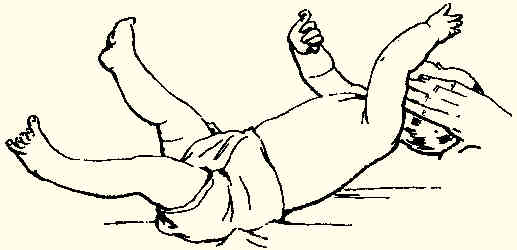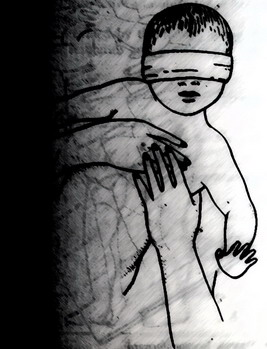Examination of vestibular system in children and infants
Contents
- 1 Introduction:
- 2 History taking:
- 3 Points to remember regarding development of inner ear:
- 4 Neck righting:
- 5 Asymmetric tonic neck reflex:
- 6 Symmetric tonic neck reflex:
- 7 Moro reflex:
- 8 Vertical acceleration:
- 9 Doll's Eye phenomenon:
- 10 Parachute reflex:
- 11 Hopping reaction:
- 12 Electronystagmography:
- 13 Ice - Cold caloric irrigation:
- 14 Optokinetic stimulation:
- 15 Bithermal caloric testing:
Introduction:
Examination of vestibular system in an infant or child is an arduous task. Adding to the obvious difficulties in clinical examination the child could be apprehensive and non co operative. In infants the process of examination could be very exacting. Vestibular dysfunction in children can present in a variety of ways ranging from a slight delay in acquiring head and postural control to acute episodes of vertigo and loss of balance. Since there is a close interaction between the vestibular, visual, proprioceptive, cerebellar and motor pathways in the maintenance of postural control and equilibrium in space it is very difficult to single out one faulty system as a reason for the defect.
History taking:
A good history is a must before the actual examination of a dizzy child. It should concentrate on developmental milestones, history of drug intake.
A good history should include:
1. Pregnancy:
a. Intra uterine infections like toxoplasmosis, rubella
b. Rh incompatibility
c. Ingestion of ototoxic drugs
d. Gestational diabetes
e. Toxemia of pregnancy
2. Neonatal period:
a. Neonatal asphyxia
b. Neonatal jaundice
c. Respiratory distress syndrome
d. CNS infections, sepsis
e. Craniofacial anamolies
3. Developmental milestones:
Sitting, standing, walking and speech
4. History of otitis, mastoiditis, head injury, CNS infections
Points to remember regarding development of inner ear:
1. Vestibular receptors are fully active and developed by 32 weeks of gestation. Hence Moro reflex can be theoretically elicited from this period till the child is 3 - 5 months of age.
2. Myelination of vestibular nerve fibers begins at about 16 weeks of gestation and is virtually complete at the time of birth
To facilitate examination of a dizzy child, they are divided into 4 groups according to their age and levels of maturation of the central nervous system. They are:
Group I: Children under the age of 4 months are grouped here. In this group the tonic neck reflexes predominate. These reflexes can be demonstrated by passive or active motions of the head relative to the position of the body. This reflex is due to movement of endolymphatic fluid through the semicircular canals. These tonic neck reflexes are dependent on the integrity of vestibular and proprioceptive systems.
Neck righting:
In this test active / passive rotation of head from the midline to one side when the infant is lying supine will cause a rotation of the whole body in the direction of head turn.
Asymmetric tonic neck reflex:
This reflex is obtained with the baby lying supine with the head in midline position. Active or passive rotation of the head to one side while the infant's chest is restrained will produce flexion of the arms and legs on the side of the occiput with extension of arms and legs on the opposite side.
Symmetric tonic neck reflex:
This reflex has two stages. In the fist stage, the baby is held in a horizontal prone position with the baby's chest in the examiner's arm or with the baby's chest on the examiner's lap. Dorsiflexion of the head will produce extension of the upper extremities and flexion of lower extremities. In the second stage, abrupt ventroflexion of the head will produce flexion of the upper extremities and extension of lower extremities.
Moro reflex:
For testing the moro reflex the baby is made to lie in the supine position with the head ventroflexed and supported by the examiners hand. Now the head is abruptly dorsiflexed about 30 degrees in relation to the trunk. This movement will produce an extension and abduction of the arms, followed by an embrace. This reflex is otherwise known as startle reflex.
These tonic neck reflexes can be absent in the following situations:
1. Complete absence of labyrinthine control
2. In severely asphyxiated hypotonic child with severe central nervous system depression
3. Severe myopathic disorders
Vertical acceleration:
In this test the baby is held in a supine position on the examiner's extended forearms. The head and trunk must be aligned and parallel to the ground. A rapid downward acceleration is produced to the baby's horizontal body by the examiner, who bends on his / her knees to a crouched position. A normal reflex response consists of abduction and extension of the arms with fanning of the hands. This response is similar to that of startle reflex (Moro's reflex). The only difference being the absence of dorsiflexion of the head, which eliminates proprioceptive input from the cervical vertebrae. Since the stimulus is vertical acceleration, it most probably stimulates the maculae of the utricle, as opposed to the cristae of the semicircular canals that are stimulated with the Moro reflex.
Doll's Eye phenomenon:
In testing for dolls eye phenomenon, the baby is held vertically under the armpits, with the head held 30 degrees forwards over the chest and is rotated for 360 degrees around an axis passing through the examiners head. Ten rotations in one direction are sufficient and provides a strong vestibular stimulus. The normal response is deviation of the eyes and head opposite to the direction of rotation. This phenomenon is present for first 2 weeks of life in full term neonates. Premature babies may have persistent dolls eye movement until 3 months of age. Gradually, the vestibular responses mature, nystagmus is superimposed, with a quick component in the direction of rotation.
Group II: Babies of this group belong to the age group of 4 - 6 months. Babies in this age group vary in their developmental achievements. Many normal infants still have residual primitive tonic neck reflexes, while in others, righting responses will appear. Both these conditions are normal.
Group III: Babies of this group belong to 6 - 18 months. This is a period of rapid motor and sensory development. The pyramidal tract becomes myelinated. Integration of visual, labyrinthine and proprioceptive stimuli occurs during this phase. Righting reflexes are elicited by an abrupt tilt of the patient to change the patient's centre of gravity. Since the optical and vestibular righting responses are identical the baby must be tested blind folded in order to eliminate visual cues. The most important of the righting reflexes is the head righting response. This can be obtained by picking up the infant from prone / supine position and bringing it to upright position by tilting the infant sideways, forwards or backwards. Every abrupt change of the head position in space will elicit vestibular head righting response. At the same time propping reactions of the extremities may be seen.
Parachute reflex:
This is also known as sentinel reaction. This is a basic protective body mechanism present throughout life. To test this reflex the baby is held under his / her arm pits with the back towards the examiner. The child is suddenly brought vertically down. The normal response consists of extension and abduction of arms, with extension of fingers as well as righting response of the head.
Hopping reaction:
This reaction appears in normal full term infant by 8 - 10 months of age. The baby is tested in the standing position, with the examiner holding him or her around the chest and gently tilting him / her sideways, forwards or backwards. The general response is initiation of a few steps in the direction of the tilt, accompanied by righting of the head. Acquiring of this reflex is a preparatory step to walking.
Equilibrium responses:
These responses are more sophisticated and highly integrated righting reactions involving the whole of the body. This response can be tested in the sitting or kneeling position, with the examiner pulling the child by his or her arms sideways. The normal response consists of righting of the head and extension with abduction of the extremities on the side opposite to the direction of the tilt.
Electronystagmography:
is a method of recording eye movements elicited by positional testing or during labyrinthine stimulation by rotation or caloric irrigation. This test is performed in a partially darkened room with the patient blind folded to eliminate fixation of gaze or optokinetic nystagmus. Microelectrodes are applied bitemporally for recording eye movements, and a neutral electrode is applied to the nasion. A position test is performed with the infant in supine, right lateral and left lateral positions. In older child a position test is also done in a sitting position.
Perotatory stimulus can be provided by commercially available torsion swing. Two perotatory stimulations are usually recorded with a five minute interval between two stimulations. The response obtained is a summation of responses elicited from both labyrinths.
In normal infants and children, the values for the speed of the slow component, amplitude and number of beats per torsion swing are identical for both right and left beating nystagmus. The total number of beats of nystagmus to the right and left are also identical. Directional preponderance is considered when the total number of beats in one direction exceeds by 25 percent the number of beats in the other direction. When directional preponderance is persent it suggests vestibular dysfunction.
Ice - Cold caloric irrigation:
Intra canalicular irrigation of cold water which is about 7 degrees less than that of body temperature stimulates the lateral canal. This test is ideally performed with the baby blind folded, in the supine position, with the head ventroflexed at 30 degrees. The child is also restrained. A ten second irrigation is a must for adequate stimulus. Recording should start immediatly after the onset of irrigation. If the child is sleepy or irritable during the test the response may not be accurate. This test is a rather crude way of testing vestibular response to a stimulus. This test is hence performed only in cases of extreme doubts regarding the function of vestibular apparatus. There is a maturation pattern in the development of caloric evoked nystagmus response. The amplitude and the number of beats increase in the first three months of life. The intensity of the nystagmus is directly proportional to the gestational age and the weight at birth. The latency of the response decreases with the gestational age and increasing birth weight.
Optokinetic stimulation:
Optokinetic nystagmus can be evaluated in most children within three to six months of birth. As the child grows older, they learn to pay more attention to the moving images and better responses can be obtained in them. This nystagmus can be recorded in response to two speeds of rotation i.e. 3 degrees and 16 degrees per second. The frequency, amplitude and speed of the slow component can be analysed in response to the two rotational speeds. The information obtained is helpful in the evaluation of overall quality of neurovestibular function.
Bithermal caloric testing:
This test involves irrigation of the external canal for 30 seconds with water at 30 degrees and 44 degrees centigrade. A 10 minute interval is allowed between irrigations. This test is performed only in children aged 4 and older. The intensity of nystagmus represented by the speed of the slow component at the end point of nystagmus is used for calculations. It takes about 45 minutes for the procedure to be complete. Children younger than 4 years may not co operate this long.
Jongkee's formula is used to calculate directional preponderance:
(R) 30 degrees + (R) 44 degrees - (L) 30 degrees + (L) 44 degrees X 100
(R) 30 degrees + (R) 44 degrees + (L) 30 degrees + (L) 44 degrees







